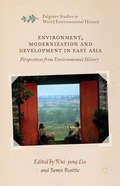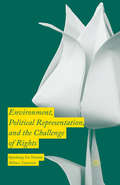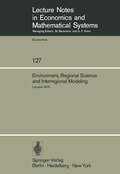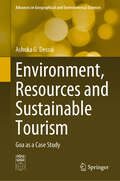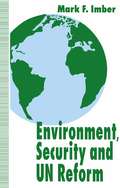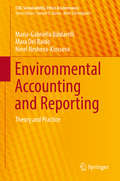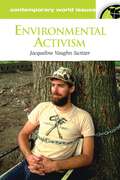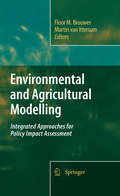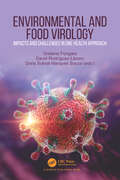- Table View
- List View
Environment, Modernization and Development in East Asia: Perspectives from Environmental History (Palgrave Studies in World Environmental History)
by Ts’ui-Jung LiuEnvironment, Modernization and Development in East Asia critically examines modernization's long-term environmental history. It suggests new frameworks for understanding as inter-related processes environmental, social, and economic change across China and Japan.
The Environment of Man (Biology And Environment Ser.)
by Richard Nathaniel T-W-FiennesEnvironment of Man is the eighth of the Croom Helm series of mono graphs on Biology and the Environment. The first volume, by this author, was a straightforward review of the principles of ecology as applied to the history of the earth. The second volume by J.L. Cloudesley-Thompson applied ecological principles to terrestrial habitats, and was followed by two volumes by C. F. Hickling and E. J. Ferguson-Wood on the ecology of aquatic habitats. The fifth volume, by Robert L. Snyder, reviews the natural ecological safeguards which control excessive growth of popUlation and discusses how these are operative in relation to the human race. Snyder's volume introduces man to the ecological scene and leads to the monograph by L. Harrison Matthews on the relationships of man with wildlife. In the seventh volume, Sir Cedric Stanton Hicks introduces us to the effects of agriculture on the ecology of the earth.
The Environment of the Earth (Astrophysics and Space Science Library #28)
by F. DelobeauAmong the many works devoted to our space environment, this serious and objective book by Mr. Delobeau should occupy a special place. It has become rare for works on such a subject to be written by competent physicists who are not specialists in the use of space vehicles. While performing research on the ionosphere, Mr. Delobeau was directly involved with the terrestrial environment long before it became common to explore it with sounding rockets and satellites. His professional obligations no longer require him to study aeronomy, only his regular collaboration with a great scientific journal inspires him to keep up to date on this subject. He is particularly motiva ted by a disinterested appreciation of the information which he hopes to share with his readers. It is a sign of the times that the results of space research should no longer be confined to the circle of space technicians. All of the new tools available to the service of science, for example:-particle accelerators, magnetic resonance, electron microscopy, lasers - have entered the general arsenal following a period of adaptation. Like them, the rocket is now a classical instrument, and gives information even to those for whom it holds no interest in itself. This book was quite up-to-date when the author submitted his manuscript. Despite the efforts of the editor, this will no longer be completely true when it appears in print. There is scarcely any branch of science that evolves more rapidly than space research.
Environment, Political Representation and the Challenge of Rights: Speaking for Nature
by Mihnea TanasescuTanasescu examines the rights of nature in terms of its constituent parts. Besides offering a thorough theoretical grounding, the book gives a first detailed overview of the actual cases of rights for nature so far. This is the first comprehensive treatment of the rights of nature to date, both analytically and in terms of actual cases.
Environment, Regional Science and Interregional Modeling: Proceedings of the International Conference on Regional Science, Energy and Environment II, Louvain, May 1975 (Lecture Notes in Economics and Mathematical Systems #127)
by M. Chatterji P. Van RompuyThis second volume of proceedings of the International Conference on Regional Science, Energy and Environment (Louvain, May 1975) contains papers related to general and partial equilibrium models of regional and urban development, in which natural and human resources playa dominant role. It need not be stressed that environmental factors and resource management have,to some extent, been neglected in postwar economic research. Unfortunately, a world-wide energy crisis or more local environmental disruptions were necessary to draw the economist's attention on the increasing imbalance between man and environment. The topics treated in this volume reflect the shift in economic research which has taken place since the early seventies. They can be classified roughly into 4 fields. The first field deals with a welfare approach to environmental deterioration. The second area covers models of resource allocation that contain environmental constraints. The third class of problems focuses on the relationship between environment and urban development. Finally, some methodological papers are included that explore new areas in regional and ~nterregional model building. Klaassen opens this volume with a paper on the impact of rising energy prices on the structure of regional development and environment, He analyses the change in size of all potentials and the consequent decrease in the volume of traffic. Besides these short-run influences, a :reallocat{o~ of households and firms may be expected in the long-run.
Environment, Resources and Sustainable Tourism: Goa as a Case Study (Advances in Geographical and Environmental Sciences)
by Ashoka G. DessaiThis book suggests sustainable economy from the viewpoint of tourism fostering low carbon footprint. Focussed on conserving heritage, culture and endemic biota of a crucial biodiversity hotspot of the world, the book discusses the impact of a large population, fast-paced development and excessive consumption of earth resources by tourism in a developing economy. The book (i) assesses the impact of overexploitation of earth resources on environmental components such as air, water, land and people, (ii) examines the sustainability of tourism on the physical, economic and socio-cultural environment including human lifestyles, (iii) presents the potential of tourism in promoting sustainable development, poverty alleviation and conservation of nature and (iv) formulates recommendations for tourism, fostering sustainable development in Goa, India. The book offers students, researchers, academics and professionals a comprehensive discourse integrating geological and societal perspectives on core issues. It generates critical thinking on the complex issue of sustainable tourism by providing in-depth perspective on peoples of different hues and their role in safeguarding the future of this unique region.
Environment, Security and UN Reform
by M. ImberThis book presents a study of international relations theory and the role of the United Nations in international environmental negotiations. The book links discussion of three issues: the persistence of third-world debt, the environmental abuse of the global commons and the financial and institutional crises within the UN system. It includes a summary of both the achievements and limitations of the 1992 Rio Summit, (UNCED), and concludes with far reaching proposals for the restructuring of UN activities.
Environmental Accounting and Reporting: Theory and Practice (CSR, Sustainability, Ethics & Governance)
by Maria-Gabriella Baldarelli Mara Del Baldo Ninel Nesheva-KiossevaThis book discusses the foundations of social and environmental accounting and highlights local differences in countries like Italy and Bulgaria. It also describes the institutional environment, which affects the development and application of environmental accounting and reporting, as a basis for evaluating current achievements and the future steps that need to be taken to develop and spread environmental accounting. The book is unique in presenting exemplary cases from different emerging and developed countries. It is a valuable resource for theorists in the field, practitioners in companies, as well as investors and other stakeholders. Moreover, it provides students with the necessary theoretical constructs, empirical studies as well as practical and managerial tools to allow for a quick orientation in the methodology, techniques and selected practices used in environmental accounting and reporting.
Environmental Activism: A Reference Handbook (Contemporary World Issues)
by Jacqueline VaughnA balanced presentation chronicling both the major events that sparked environmental activism and the nature of that activism in the past century.Beginning with an overview of activism in the past century from 1900 to 2001, Environmental Activism: A Reference Handbook puts organizations and their activities into historical context. This volume offers both an American perspective and a global perspective. It chronicles the major events that sparked environmental actions; aligns individuals with organizations, such as John Muir and the Sierra Club; and presents a balanced treatment of activities in both conservative and liberal political spheres.Separate chapters identify six eras of activism from 1900 to 2001 and include their characteristics, issues, strategies, and advocates. This is followed by summaries of the various types of organizations and their strategies, including direct action (ecoterrorism, monkey wrenching) as well as mainstream activity (lobbying, letter writing).
Environmental Adaptations and Stress Tolerance of Plants in the Era of Climate Change
by Parvaiz Ahmad and M.N.V. PrasadClimate change is a complex phenomenon with a wide range of impacts on the environment. Biotic and abiotic stress are a result of climate change. Abiotic stress is caused by primary and secondary stresses which are an impediment to plant productivity. Prolonged exposure to these stresses results in altered metabolism and damage to biomolecules. Plants evolve defense mechanisms to withstand these stresses, e.g. synthesis of osmolytes, osmoprotectants, and antioxidants. Stress responsive genes and gene products including expressed proteins are implicated in conferring tolerance to the plant. This volume will provide the reader with a wide spectrum of information, including vital references. It also provides information as to how phytoconstituents, hormones and plant associated microbes help the plants to tolerate the stress. This volume also highlights the use of plant resources for ameliorating soil contaminants such as heavy metals. Dr. Parvaiz is Assistant professor in Botany at A.S. College, Srinagar, Jammu and Kashmir, India. He has completed his post-graduation in Botany in 2000 from Jamia Hamdard New Delhi India. After his Ph.D from the Indian Institute of Technology (IIT) Delhi, India in 2007 he joined the International Centre for Genetic Engineering and Biotechnology, New Delhi. He has published more than 20 research papers in peer reviewed journals and 4 book chapters. He has also edited a volume which is in press with Studium Press Pvt. India Ltd., New Delhi, India. Dr. Parvaiz is actively engaged in studying the molecular and physio-biochemical responses of different plants (mulberry, pea, Indian mustard) under environmental stress. Prof. M.N.V. Prasad is a Professor in the Department of Plant Sciences at the University of Hyderabad, India. He received B.Sc. (1973) and M.Sc. (1975) degrees from Andhra University, India, and the Ph.D. degree (1979) in botany from the University of Lucknow, India. Prasad had published 216 articles in peer reviewed journals and 82 book chapters and conference proceedings in the broad area of environmental botany and heavy metal stress in plants. He is the author, co-author, editor, or co-editor for eight books. He is the recipient of Pitamber Pant national Environment Fellowship of 2007 awarded by the Ministry of Environment and Forests, Government of India.
Environmental Alteration Leads to Human Disease: A Planetary Health Approach (Sustainable Development Goals Series)
by Giuseppe La Torre Vittorio Ingegnoli Francesco LombardoThis book aims to explore the impact of human alterations of Earth’s ecological systems on human health. Human activities are producing fundamental biophysical changes faster than ever before in the history of our species, which are accompanied by dangerous health effects. Drawing on advanced ecological principles, the book demonstrates the importance of using systemic medicine to study the effects of ecological alterations on human health. Planetary Health is an interdisciplinary field, but first of all it must be systemic and it needs a preferential relationship between Ecology and Medicine. This relation is to be upgrading, because today both ecology and medicine pursue few systemic characters and few correct interrelations. We need to refer to new principles and methods sustained by the most advanced fields, as Landscape Bionomics and Systemic Medicine. Thus, we will be able to better discover environmental syndromes and their consequences on human health. Environmental transformations proposed by PHA (from biodiversity shifts to climate change) do not consider bionomic dysfunctions which can menace human health. On the contrary, finding advanced diagnostic criteria in landscape syndromes can strongly help to find the effects on human well-being. The passage from sick care to health care can’t avoid the mentioned upgrading.
Environmental Analysis and Technology for the Refining Industry (Chemical Analysis: A Series of Monographs on Analytical Chemistry and Its Applications #167)
by James G. SpeightA timely, hands-on guide to environmental issues and regulatory standards for the petroleum industry Environmental analysis and testing methods are an integral part of any current and future refining activities. Today's petroleum refining industry must be prepared to meet a growing number of challenges, both environmental and regulatory. Environmental Analysis and Technology for the Refining Industry focuses on the analytical issues inherent in any environmental monitoring or cleanup program as they apply to today's petroleum industry, not only during the refining process, but also during recovery operations, transport, storage, and utilization. Designed to help today's industry professionals identify test methods for monitoring and cleanup of petroleum-based pollutants, the book provides examples of the application of environmental regulations to petroleum refining and petroleum products, as well as current and proposed methods for the mitigation of environmental effects and waste management. Part I introduces petroleum technology, refining, and products, and reviews the nomenclature used by refiners, environmental scientists, and engineers. Part II discusses environmental technology and analysis, and provides information on environmental regulation and the impact of refining. Coverage includes: * In-depth descriptions of analyses related to gaseous emissions, liquid effluents, and solid waste * A checklist of relevant environmental regulations * Numerous real-world examples of the application of environmental regulations to petroleum refining and petroleum products * An analysis of current and proposed methods of environmental protection and waste management
Environmental Analysis by Electrochemical Sensors and Biosensors: Fundamentals (Nanostructure Science and Technology)
by Ligia Maria Moretto Kurt KalcherThis book presents an exhaustive overview of electrochemical sensors and biosensors for the analysis and monitoring of the most important analytes in the environmental field, in industry, in treatment plants and in environmental research. The chapters give the reader a comprehensive, state-of-the-art picture of the field of electrochemical sensors suitable to environmental analytes, from the theoretical principles of their design to their implementation, realization and application.The first three chapters discuss fundamentals, and the last three chapters cover the main groups of analytes of environmental interest.
Environmental Analysis by Electrochemical Sensors and Biosensors: Applications (Nanostructure Science and Technology)
by Ligia Maria Moretto Kurt KalcherThis book discusses in detail the analysis and monitoring of the most important analytes in the environmental field. It also reviews the implementation, realization and application of sensor designs mentioned in the first volume of this set, dividing the coverage into global parameters, sensors of organics and sensors of inorganics.
Environmental Analysis Laboratory Handbook
by Anshul Nigam Rupal GuptaToday, environmental issues are a great cause of concern at the global level, and universities and other institutions around the world are involved in research on climate change, deforestation, pollution control, and many other issues. Moreover, environmental science and environmental biotechnology are inherent parts of various courses while some universities provide degrees in these fields. Although the environment perspective of water is discussed time and again in research, academic, and non-academic discussions, there is no book summarizing protocols involved in water quality analysis. The information seems to be sporadically distributed on the internet. Even if available at all, the information does not discuss limits of the protocols or caveats involved. For example, essays on chemical oxygen demand (COD) on the internet mostly do not discuss differences between organic compounds of biological origin and aliphatic/aromatic. The authors have performed nearly all the protocols mentioned in this new volume, and their protocols are discussed in a simplified, easy-to-understand manner. The book has been written after elaborative discussions with and input from faculty and research students to ensure the clarity of the material for use on many levels. Further, the authors have emphasized low-cost methods which involve minimal use of high-end instrumentation keeping in mind limitations faced in developing countries. A valuable reference for engineers, scientists, chemists, and students, this volume is applicable to many different fields, across many different industries, at all levels. It is a must-have for any library.
Environmental Analysis Laboratory Handbook
by Anshul Nigam Rupal GuptaToday, environmental issues are a great cause of concern at the global level, and universities and other institutions around the world are involved in research on climate change, deforestation, pollution control, and many other issues. Moreover, environmental science and environmental biotechnology are inherent parts of various courses while some universities provide degrees in these fields. Although the environment perspective of water is discussed time and again in research, academic, and non-academic discussions, there is no book summarizing protocols involved in water quality analysis. The information seems to be sporadically distributed on the internet. Even if available at all, the information does not discuss limits of the protocols or caveats involved. For example, essays on chemical oxygen demand (COD) on the internet mostly do not discuss differences between organic compounds of biological origin and aliphatic/aromatic. The authors have performed nearly all the protocols mentioned in this new volume, and their protocols are discussed in a simplified, easy-to-understand manner. The book has been written after elaborative discussions with and input from faculty and research students to ensure the clarity of the material for use on many levels. Further, the authors have emphasized low-cost methods which involve minimal use of high-end instrumentation keeping in mind limitations faced in developing countries. A valuable reference for engineers, scientists, chemists, and students, this volume is applicable to many different fields, across many different industries, at all levels. It is a must-have for any library.
Environmental and Agricultural Modelling: Integrated Approaches for Policy Impact Assessment
by Floor M. Brouwer Martin IttersumAgriculture increasingly faces the challenge of balancing its multiple functions in a sustainable way. Integrated assessment and modelling (IAM) can provide insight into the potential impacts of policy changes. However, concepts to address the wide range of issues and functions typical for agriculture are still scarce. Environmental and Agricultural Modelling reviews and presents our current understanding of integrated and working tools to assess and compute, ex-ante, alternative agricultural and environmental policy options, allowing: 1. Analysis at the full range of scales (farm to European Union and global) whilst focusing on the most important issues emerging at each scale; 2. Analysis of the environmental, economic and social contributions of agricultural systems towards sustainable rural development and rural viability; 3. Analysis of a broad range of issues and agents of change, such as climate change, environmental policies, rural development options, effects of an enlarging EU, international competition, and effects on developing countries.
Environmental and Biological Control of Photosynthesis: Proceedings of a conference held at the ‘Limburgs Universitair Centrum’, Diepenbeek, Belgium, 26–30 August 1974
by R. MarcelleThis book reports the proceedings of a meeting held in the 'Limburgs Universitair Centrum' , Diepenbeek, Belgium, August 26 to 30, 1974. In convening this meet ing, my aim was to bring together a small number of specialists working on photosynthesis of course but also always keeping in mind that plants are in fluenced by their environment (temperature, light quality and intensity, air com position, daylength . . . . . ) and can differently react according to their stage of deve lopment. In general, all these specialists work on whole plants cultivated in well known conditions (they are not 'market spinach specialists') but, when necessary, give up the idea of measuring photochemical activities in isolated they don't chloroplasts, enzyme kinetics . . . etc. It is noticeable that about 50% of them are working in laboratories directly involved with applied research in agriculture or forestry. The format of the meeting was intentionally kept small but it allowed generous time for discussion; thanks are due to Drs. O. BJÖRKMAN, J. W. BRADBEER, M. M. LUDLOW and C. B. OSMOND for taking the chairs during these discussions. In such a small meeting, the choice of invited scientists was really a personnal one and thus reflected my own fields of interest. When planning the conference, I was continually divided between the wish for inviting other interesting people and the necessity of keeping time free for discussions.
Environmental and Construction Engineering: Selected Papers (Lecture Notes in Civil Engineering #160)
by Sergey Vasil’yevich Klyuev Alexander Vasil’yevich KlyuevThis book gathers the latest advances, innovations, and applications in the field of construction engineering, as presented by researchers and engineers at the International Conference Environmental and Construction Engineering: Reality and the Future, held in Belgorod, Russia, on May 18-19, 2021. It covers highly diverse topics, including industrial and civil construction, building materials; environmental engineering and sustainability; machines, aggregates and processes in construction. The contributions, which were selected by means of a rigorous international peer-review process, highlight numerous exciting ideas that will spur novel research directions and foster multidisciplinary collaborations.
Environmental and Ecological Sustainability Through Indigenous Traditions: Perspectives from the Global South
by Binay Kumar PattnaikThis book explores the environmental and ecological wisdom inherent in some of the indigenous traditions of traditional communities from developing societies like, Argentina, Brazil, India, Mexico, Sri Lanka, and Thailand. It throws light on how these discrete and unrecognized traditions have enabled communities to live in harmony with nature for ages. Despite the best efforts of the modern states through policy-making, intensive R&D for eco-friendly technologies and products, social and environmental impact assessment studies (SEIAS), and cost benefit analysis (CBA) of projects, environmental and ecological degradation continues, mostly in developing societies, which house large number of traditional communities. This book explores their traditions consisting of world views or cosmologies, eco-savvy-customs, indigenous knowledge systems involving community-based occupations and practices, skills and crafts, and so on. This book shows that when interpreted in consonance with scientific environmentalism, these traditions reveal their inbuilt environmental wisdom, mirroring sacredness of nature that have instilled built-in conservation practices, are key to sustainability.The conception of indigenous traditions that subsume environmental and ecological sustainability as well as cultural identity is studied in the book, from the vantage of multi-disciplinary perspectives. This book reflects two streams of thought : (i) stream of social anthropology, arguing for the inbuilt strength of indigenous traditions, that necessitate empathetic understanding with their own rights for recognition and survival, and (ii) stream of indigenous knowledge systems being technically effective only necessitate validation and certification by modern scientific knowledge system for wider use. The book is of great use to policy-makers and non-government players, in addition to researchers and academicians working in the area of sustainable development and indigenous / traditional communities.
Environmental and Financial Performance Evaluation in 3D Printing Using MFCA and LCA (SpringerBriefs in Applied Sciences and Technology)
by Marcell Mariano Corrêa Maceno Tiago Yuiti Kamiya Mariana KleinaThis book presents the methodology of environmental and financial performance evaluation in 3D printing processes using the MFCA and LCA. This methodology is divided into 7 main steps, which are: a) identification of the analysis problem (for example, comparison of different types of 3D printer for use in a given purpose, comparison of different printing materials for the same 3D printer technology, among others) and definition of printing parameters; b) definition of the product to be printed; c) preparation of the printing process flow diagram; d) definition or measurement of the lifespan of the printed product; e) data collection for the implementation of the LCA tool (for example, mass and energy balances); f) data collection for the implementation of the MFCA tool (for example, mass balances, energy balances, mass costs, energy costs, labor costs, etc.); and g) comparative assessment of the financial and environmental performance of 3D printing. As a way of exemplifying the application of this methodology, a real case is presented involving the comparison of two types of materials (Polylactic Acid – PLA – and Polyethylene Glycol Polyterephthalate – PETG) used in the 3D printing process by FDM technology. The part printed in this real case was a clearance gauge used as a joint spacing control by an automobile industry located in Brazil. The development of the methodology and consequent application has shown that it can be used by users of 3D printing, in the most diverse areas, to support their decision in choices that can present the best performance, both financial and environmental.
Environmental and Food Safety and Security for South-East Europe and Ukraine (NATO Science for Peace and Security Series C: Environmental Security)
by Ksenija VitaleThis book covers important aspects of the field of food security and safety, ranging from fundamental production, through advanced water treatment technologies and detection of novel pollutants, to management and policy making. The discussion strives to develop an integrated approach to solving the associated problems by simultaneously considering sociological, ecological and economic aspects. Special focus is on the environmental management systems that should be integrated in the processes of environmental risk assessment. Also addressed are other technologies applied in the service of detecting, preventing and monitoring possible threats to food security and safety. With its variety of subjects, this volume can serve both as a textbook for advanced studies and as a useful reference source for professionals.
Environmental and Food Virology: Impacts and Challenges in One Health Approach
by Gislaine Fongaro David Rodr Doris Sobral Marques SouzaEnteric pathogenic viruses are a major challenge in public health, as they represent a major concern with a severe global impact to the economy, commerce, and health systems. Consequently, their active monitoring can allow preventive surveillance and the discovery of new viruses, exemplifying an important epidemiological and health control tool.In an unprecedented way, this book addresses the general characteristics of enteric viruses and their environmental transmission, with a particular emphasis on their structures, stability, routes of transmission and the use of bioindicators for epidemiological monitoring and control. In addition, this book will also address the recent developments for viral concentration and detection in environmental and food samples and the challenges for the control of environmental and food viruses to reduce microbiological risk for final consumers.
Environmental and Food Virology: Impacts and Challenges in One Health Approach
Enteric pathogenic viruses are a major challenge in public health, as they represent a major concern with a severe global impact to the economy, commerce, and health systems. Consequently, their active monitoring can allow preventive surveillance and the discovery of new viruses, exemplifying an important epidemiological and health control tool.In an unprecedented way, this book addresses the general characteristics of enteric viruses and their environmental transmission, with a particular emphasis on their structures, stability, routes of transmission and the use of bioindicators for epidemiological monitoring and control. In addition, this book will also address the recent developments for viral concentration and detection in environmental and food samples and the challenges for the control of environmental and food viruses to reduce microbiological risk for final consumers.
